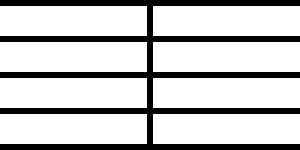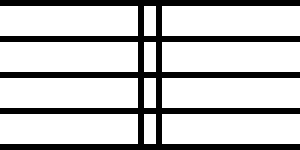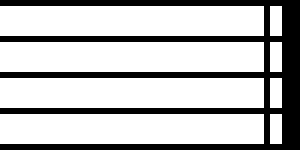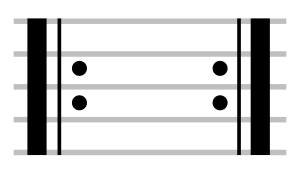Bar (music) facts for kids
In music, a bar (also called a measure) is like a small section that helps organize written music. Think of it as a short period of time in a song. Most music has a steady beat, and each bar usually holds the same number of these beats. For example, if a song feels like "ONE-two-three-four, ONE-two-three-four," each bar would contain four beats of music.
Contents
What Are Bar Lines in Music?
A bar line is a straight vertical line drawn in music. It acts like a divider, separating one bar from the next. These lines help musicians easily read and understand where the beats are grouped.
At the very beginning of a piece of music, you will see a time signature. This special symbol tells you how many beats are in each bar and what kind of note gets one beat. The top number of the time signature shows how many beats are in every bar.
What Are Double Bar Lines?
A double bar is not two separate bars of music. Instead, it is two single bar lines drawn close together. These double lines are used to show important sections or changes in the music.
Sometimes, one of the lines in a double bar is thicker than the other. This special double bar line means the end of a piece of music. It tells the musician that the song is finished.
What Are Repeat Signs?
If you see a double bar line with two dots on its left side, it's a repeat sign. This tells the musician to go back to the beginning of the song and play it again.
If the composer wants only a certain part of the music to be repeated, they will add a "start repeat" sign. This is a double bar line with two dots on its right side. The musician then repeats the section between the "start repeat" and the "end repeat" signs.
How Do Conductors Use Bars?
The first beat of every bar usually feels stronger than the other beats. When a conductor leads an orchestra, their hand or baton always moves DOWN on this strong first beat. This downward motion helps everyone feel the start of a new bar. The last beat of a bar is often called an "upbeat" because the conductor's hand moves upwards.
When Were Bar Lines First Used?
Musicians and composers have been using bar lines to organize music since around the year 1600. They have been a helpful tool for centuries to make music easier to read and play.
Images for kids
See also
 In Spanish: Barra de compás para niños
In Spanish: Barra de compás para niños








